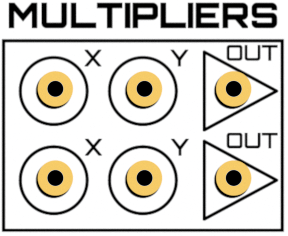Multiplier
The Multiplier is an analog computing element which is capable of performing the multiplication of two quantities X * Y = OUT. We call X and Y the factors and OUT the product. The Analog Thing has two multipliers, which means you can do two multiplications in a single circuit. However, alternatives exist: If you only want to multiplicate with a constant, use a Coefficient/Potentiometer.
Multiplication in electrical analog computers is one of the hardest basic arithmetic operations, since there is no fundamental process in nature which could be exploited. The THAT features a four quadrant multiplier (Gilbert cell) which is by far the most expensive part of the overal board. This is the reason why there are only two multipliers on the overall board.
Usage of the Multiplier
- Choose one multiplier which is free. Each row is a single multiplier.
- Connect something to the inputs (round circles
XandY). Only connect a single jack, do not stack jacks. - Use the output (triangular circuit), you can connect multiple jacks if you want.
Interestingly, the multiplication can never produce an overload. This is easy to see: If -1 < X < 1 and -1 < Y < 1, then 0 < Z < 1.
Chip
In The Analog Thing, the AD633JR is used for multiplication. You can find it in the schematics for instance in File:Anathing_v1.0_base_4.pdf.
